Sagittaria L. (Alismataceae)
Sagittaria is represented by seventeen taxa in North Carolina. Only S. fasciculata is listed at the federal level (Fed E, S1 G2). Four additional species are state listed: S. chapmanii (State T, S1 G3?), S. isoetiformis (State T, S2 G4), S. macrocarpa (State T, S2 G2), and S. weatherbiana (State E, S2 G3G4). All species listed fall into a group of taxa exhibiting leaves linear to lanceolate, not sagittate or cordate. Sagittaria fasciculata is the only linear-lanceolate-leaved species in the genus occurring in the mountains in North Carolina. Additional species of conservation concern tracked by NHP are S. filiformis (State SR-P, SH G4G5) and S. spatulata (State SR-P, SH G4), both historical in the state.
Federally listed taxon—
Sagittaria fasciculata (Fed E, State E | S2 G2)
Habitat. "Seepage areas with very low water flow and no stagnation; soils are sandy loams overlain by muck 10-24 inches deep; some shade is beneficial" (USFWS).
Range. Endemic to western North and South Carolina.
Additional resources. NHP | Recovery plan | 5-year review
Key to Sagittaria in North Carolina
Key adapted from Haynes and Hellquist (2000 [FNA]) and Weakley (2008). Photos by Krings, unless indicated otherwise. Line drawings from Britton & Brown (1913), unless indicated otherwise. Maps courtesy of USDA PLANTS and the North Carolina Natural Heritage Program.
1. Leaf blades sagittate or cordate...[S. australis, S. calycina, S. engelmanniana, S. filiformis, S. latifolia,
S. montevidensis, S. spatulata]
1’. Leaf blades linear or lanceolate, or modified as linear, bladeless phyllodia, often spongy in texture...2.
2. Stalks of the pistillate flowers reflexed in fruit, often stout; filaments glabrous...[S. calycina, S. filiformis,
S. platyphylla, S. spatulata, S. subulata]
2’. Stalks of the pistillate flowers ascending or spreading in fruit, not notably stout; filaments roughened with minute scales (except glabrous in S. fasciculata)...3.
3. Filaments narrower than the anthers, diameter changing little from base to summit...[S. engelmanniana,
S. lancifolia]
3’. Filaments as broad or broader than the anthers, either distinctly dilated toward the base OR thickened throughout...4.
4. Plants with corms and/or stolons, lacking coarse rhizomes...5.
5. Blades of emersed leaves lanceolate, narrowly spatulate, > 5 mm wide...S. fasciculata* 
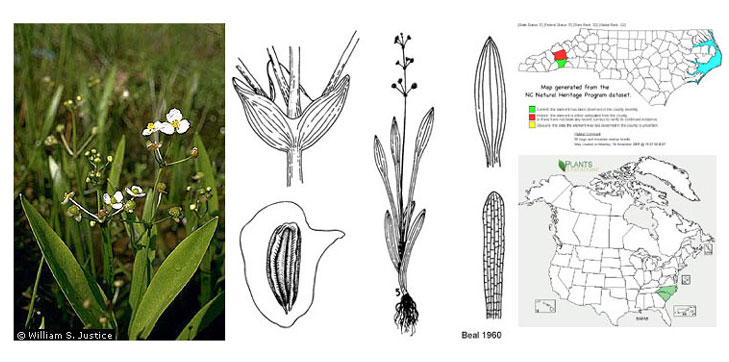

Habit of Sagittaria fasciculata (Photo: Krings)

Leaf of Sagittaria fasciculata (Photo: Krings)

Phyllodia of Sagittaria fasciculata (Photo: Krings)

Inflorescence of Sagittaria fasciculata (Photo: Krings)

Flower of Sagittaria fasciculata (Photo: Krings)

Flower of Sagittaria fasciculata (Photo: Krings)

Fruits of Sagittaria fasciculata (Photo: Krings)
Sagittaria fasciculata*
(rare [Fed E,
S1 G2]; bogs and adjacent ditches, wooded seepages; Mt; summer)
5’. Blades of emersed leaves linear (< 3 [–4] mm wide) or phyllodial...6.
6. Achenes 1.5–2.0 (–2.5) mm long; inflorescence bracts connate for > 50% of length...S. isoetiformis 
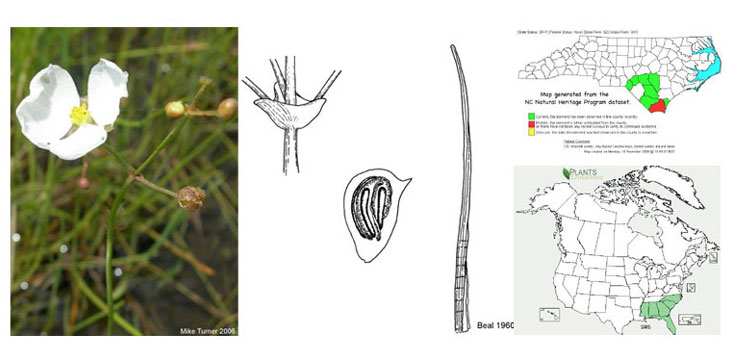

Inflorescence of Sagittaria isoetiformis (Photo: N. Howell)

Inflorescence bract of Sagittaria isoetiformis (Photo: N. Howell)

Inflorescence of Sagittaria isoetiformis (Photo: N. Howell)

Inflorescence bract of Sagittaria isoetiformis (Photo: N. Howell)
Sagittaria isoetiformis
(rare [State T, S2 G4?]; clay-based bays, CP ponds or seasonally flooded
depressions; CP)
6’. Achenes (2.2–) 2.4–3.0 mm long; inflorescence bracts connate for < 40% of length...S. macrocarpa 
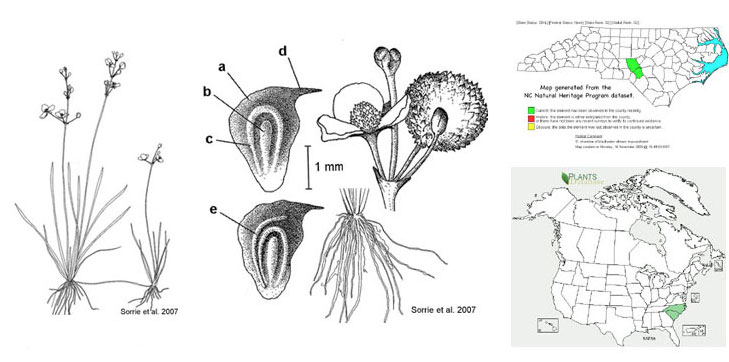

Habit of Sagittaria macrocarpa [center of photo]; note twig of Lyonica lucida [running diagonal through photo] for size reference (Photo: Krings)

Flower of Sagittaria macrocarpa; note the swollen filaments (Photo: Krings)

Infructescence of Sagittaria macrocarpa; note that stalks are ascending, not reflexed (Photo: Krings)

Inflorescence bract of Sagittaria macrocarpa (Photo: Krings)

Inflorescence bract of Sagittaria macrocarpa (Photo: Krings)

Inflorescence bract of Sagittaria macrocarpa [right lobe broken off] (Photo: Krings)

Achenes of Sagittaria macrocarpa (Photo: Krings)
Sagittaria macrocarpa
(rare [State T, S2 G2]; beaverponds, millponds; CP)
4’. Plants with coarse rhizomes, lacking corms and stolons...7.
7. Inflorescence paniculate (branched at the base in at least some plants of a population)...S. chapmanii 
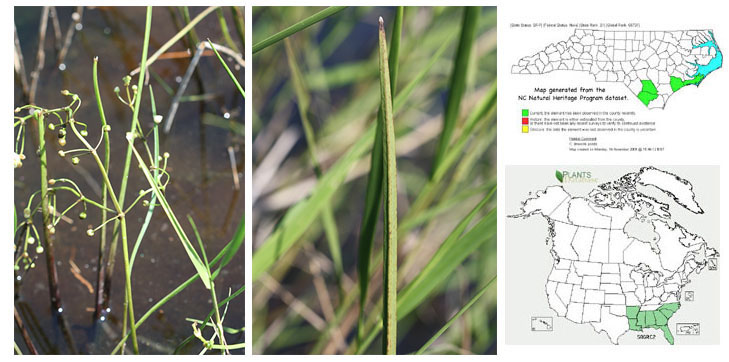

Habitat of Sagittaria chapmanii (Photo: Krings). Pond with Nymphaea odorata, Panicum hemitomum, and Anchistea virginica (along shore).

Leaves of Sagittaria chapmanii (Photo: Krings)

Leaves of Sagittaria chapmanii (Photo: Krings)

Leaves of Sagittaria chapmanii (Photo: Krings). Panicum hemitomum in background.

Inflorescence bract of Sagittaria chapmanii (Photo: Krings)

Inflorescence of Sagittaria chapmanii (Photo: Krings)

Pistillate flower of Sagittaria chapmanii (Photo: Krings)
Sagittaria chapmanii
(rare [State T, S1 G3?]; limesink ponds and mucky ditches; CP)
7’. Inflorescence racemose...8.
8. Larger phyllodia to 1 cm wide, apices acute...S. graminea 
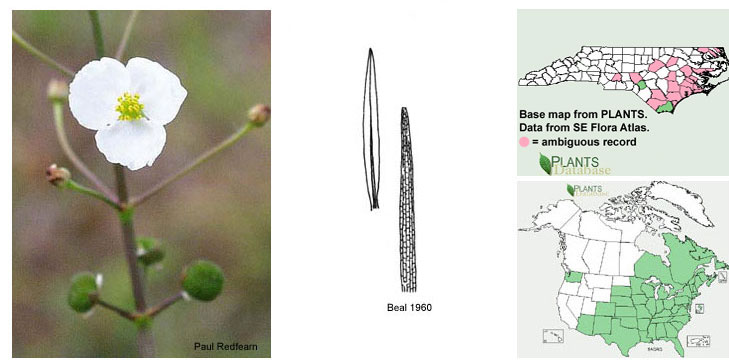 Sagittaria graminea
Sagittaria graminea
(common; marshes, ponds, tidal areas; CP)
8’. Larger phyllodia 0.8–2.5 cm wide, apices blunt (rarely acute)...S. weatherbiana 
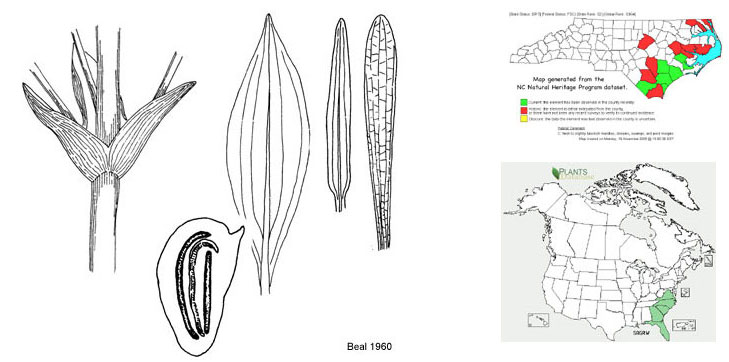
_IMG_4980_sml.jpg)
Habitat of Sagittaria weatherbiana [bottom right of photo] (Photo: Krings)

Emersed leaf of Sagittaria weatherbiana (Photo: Krings)

Phyllodial leaf of Sagittaria weatherbiana; note the obtuse leaf tip (Photo: Krings)

Immature inflorescence of Sagittaria weatherbiana (Photo: Krings)

Inflorescence of Sagittaria weatherbiana (Photo: Krings)

Inflorescence of Sagittaria weatherbiana (Photo: Krings)

Staminate flower of Sagittaria weatherbiana (Photo: Krings)
Sagittaria weatherbiana
(rare [State E, S2 G3G4]; fresh or brackish marshes, streambanks, and wet depressions; CP)






